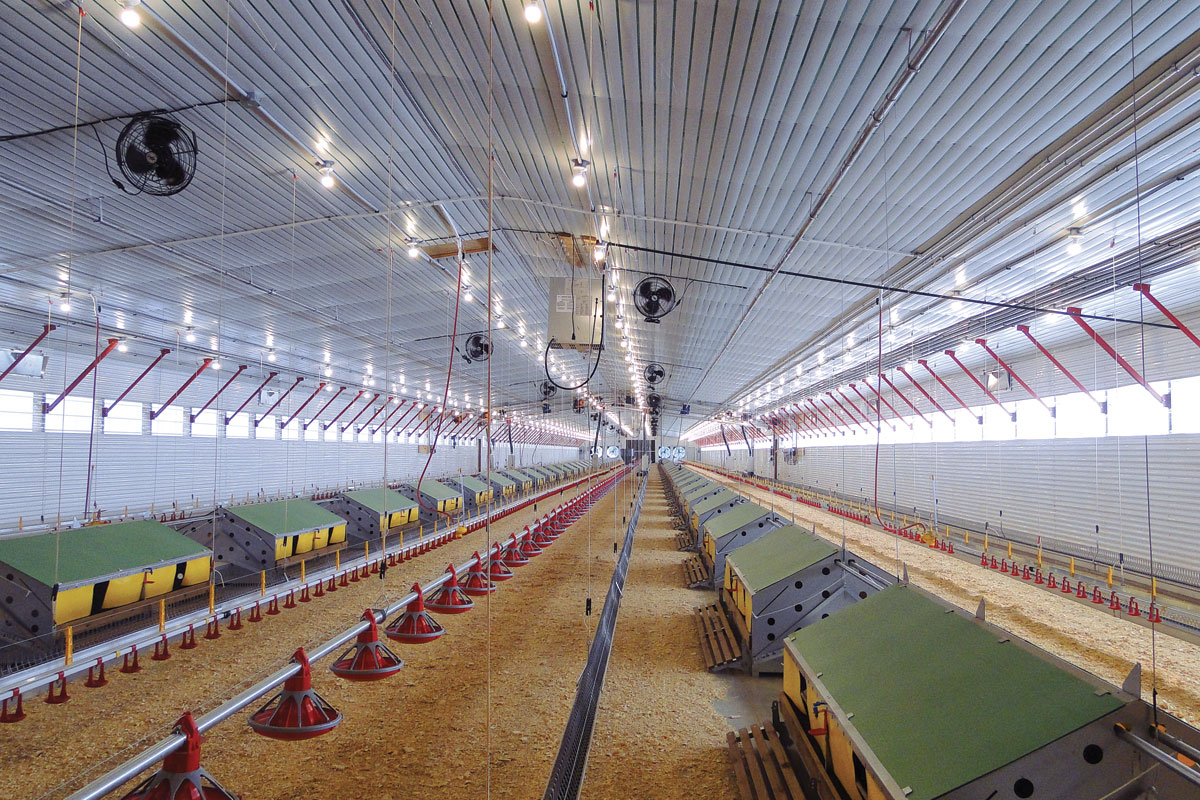
Huntsville, Ark., farm is working with Tyson on new, efficient systems in the poultry industry
Nothing is more constant than change, especially in the poultry industry. The newest innovation comes from Israel with an updated design for breeding houses.
Bryan and Stephanie Reynolds of Huntsville, Ark., are a pilot project for Tyson using the updated design. Their two breeding houses are the first in the United States with the first flock still in production. Each house holds 13,800 hens and 1,200 roosters.
“So far the system seems to be more efficient with a 5 percent average higher production rate,” Bryan said.
While the new system is definitely different than the traditional one, the changes are intended to improve efficiency without instituting a new design from the ground up. Two exterior changes bring little alteration to the traditional appearance.
The first innovation involves scales for computing daily grain usage. Each leg of the bin has an attached scale. The measurement of each scale is combined and calculated to produce an accurate weight that compensates for uneven shifting within the bin as grain is removed. Bryan and Stephanie keep track of the daily data which is then given to their field man for analysis.
The second change is to the sides of the chicken house. A clear strip runs horizontally across each side as part of the siding. The strip allows significant natural light to enter and replaces conventional curtains. The purpose is twofold. One is to create a more natural and therefore less stressful environment for the chickens. The other is better temperature and condition control throughout the year, regardless of weather. The third change is part of this system and is in the form of inlet vents for airflow at the top of the sides of the new houses. Another part of the airflow system, but unchanged from current construction methods, are seven tunnel doors where air comes in and goes through cool cells.
Inside the new houses, standard 85 KW John Deere generators and the master control computer system are the same. However, the interior does contain other significant changes.
Supporting the clear window strip along the side of the walls is a lighting system using LED lights. While supplemental LED lights are not new in broiler houses, they are in breeder houses.
Perhaps the most obvious change is a concrete floor. Concrete improves biosceurity due to the ease of complete washing and cleaning after each batch of breeder hens which is typically 45 weeks long.
To accommodate cleaning, the floor contains drains with the concrete providing a totally clean environment for each incoming flock.
“I remove the chicken litter and Tyson pays for the washing and bedding though I select the provider of those services,” Bryan explained.
Other obvious differences are the absence of slats to keep the breeder hens off of the litter and an extra feeder down the middle between the two rows of community nests. Not as obvious at first glance but even more significant are the nests themselves. The new metal and vinyl nests arrived unassembled from Israel. Workers took six days to assemble the new nests with 74 nests in each house.
Previously, breeder nests were side-by-side with each hen going into a separate scratch box. The new breeder nests are communal, which taps chickens’ natural inclination to flock and lay together. Chickens also prefer to lay in the dark. Therefore, the front of each communal nest is covered with an opaque vinyl side with two entrance holes but with each piece of vinyl being movable if a chicken wants to enter other than through the entrances.
The sides of the nesting houses are a maze color, which is very attractive to chickens, while the roofs are another favorite color: green. In addition, each house has a waterer between openings as another attractor to use the nest. Finally, the nests themselves are made of an Astroturf – like surface but stiffer.
“The hens really like the new communal houses. They wait outside for a turn to get in to lay their eggs,” Stephanie said.
Another important innovation is changing the gravity flow collection conveyor belt that runs through the center of the houses to the room where the eggs are collected and stored. Instead of being cloth, the new belts are plastic and cleaner; traveling from one end of the house to the other in 15 minutes on high speed, but much slower during peak times to allow the four hired hands to collect the eggs during the week. On weekends, Bryan and Stephanie, as well as a part-time helper, handle collection. Eggs are then stored at 70 degrees the optimum temperature for later hatching when the temperature is slowly raised.
The chickens lay almost exclusively between 8 a.m. and 4 p.m. One side of nests is used each day with the other raised by a winch system to 18 inches and thereby becoming a scratch area.
While all data for the entire production cycle is yet to be collected, Bryan and Stephanie are pleased with the initial results. Indications so far are that peak production lasts longer and the fall off production is more gradual which could provide a higher total for the cycle. As importantly, mortality rates seem about half of previous company averages.
Since the 5 percent increase production rate is determined by the number of hens in the house, the lower mortality rate will probably increase overall profit. Another profit increase may come from the ability to pick up floor eggs by hand which is not possible under the old slats system.
The Reynolds’ current flocks produces about 1,200 eggs per house per day on the floor, a number which differs significantly with each flock.
“The house system seems highly functional and beneficial, but data will need to be collected from a number of flocks before any decisions are made about going forward with this Israeli-based system design,” Stephanie said. “One change will be adapting specific protocols to fit our Cobb birds as opposed to the species the Israelis use, which are not available to us.”






